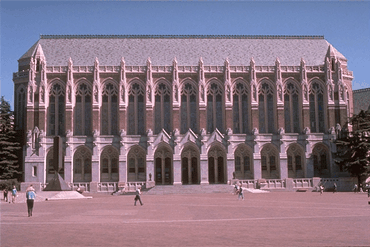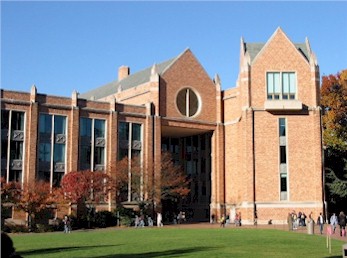When I started this program, I had never worked in a library. My first year, I became familiar with the language used in library and information science, and this instruction became vitally important when I started working at the University of Washington Libraries. I had the chance to become involved in several different aspects of librarianship, and I felt at home when even when faced with unfamiliar tasks, partially because of my coursework. It was exhilarating to put theory into practice on a daily basis, and my work made me certain that I was on the right path.
Reference Services
I had little experience in reference services, but I developed an instant attraction to this kind of work when volunteering with the Internet Public Library. At this library, I took on my first reference question where a patron asked about the eating habits of raccoons. As this is an unfamiliar topic, I was surprised that my discovery of appropriate sites proved quite satisfying. I answered more reference questions, and, during this process, I realized that my sense of satisfaction came from the knowledge that I had helped someone. The service elements of librarianship gives rise to the sense that I had made a difference, which is a very satisfying sense indeed.

Suzzallo Library
I had similar feelings when I worked at the Reference Desk at Suzzallo Library. It would be an understatement to say that I was nervous during my first day at the reference desk. Even though I had shadowed other reference librarians, I was concerned by the immense size of the reference collection at Suzzallo and feared that I would end up misdirecting patrons. However, I remembered what the head of reference services had told me when I started. She had noted that reference services are always humbling because you realize how much you don't know; you are constantly faced with questions to which you don't have the answers. Yet. But you can find the answers, and that is what is important. She advised me to remember that I did not have to be afraid of admitting that I did not have an answer. The important part was what came after that admission: showing the patron how we could find the answer.
Over the past year, I have worked with patrons to find information on everything from brain chemistry to Pakistani saints to advertisements for washing machines. I have showed students how to use databases, how to develop keywords, how to move from keyword searches to subject searches, and how to formulate research plans. This work has been fascinating and exciting, and I have discovered that curiosity and enthusiasm are as central to reference services as knowing how to use databases or plan a search. As I have an abundance of curiosity and enthusiasm, I could not help but enjoy my work at the reference desk.
Upon completing each reference interview, I take stock of what had worked and what had been less effective, and I consider what I have learned from other reference librarians and from classes on the topic. This kind of reflection helped me to develop my skills in this area, and, by the end of the year, I was confident when at the reference desk, even when taking solo shifts. By working at the reference desk, I learned not only about available resources but also about how to identify user needs, to demonstrate search techniques, and to provide direction when it came to research.
In addition to working in an academic library, I have the chance to answer questions at the desk of a public library as part of my Directed Fieldwork project. By working at the desk of a branch of the Seattle Public Library, I learned to help patrons whose questions are not necessarily related to academic research. I also have the opportunity to work with patrons from different age groups and come from different backgrounds, and my work at SPL has made me much more familiar with the Dewey classification system, which is particularly significant when considering that my previous work involved Library Congress classification schemes.

Allen Library
By working with a variety of patrons with divergent interests and information needs at SPL, the necessity of really listening to the patron and of working together to find answers has been underscored. That libraries represent a service industry was also emphasized; the public library's focus on serving the entire range of the public is a central part of the activity at SPL. The idea that we help people find what they need seemed most obvious when working at SPL.
Collection Development
My first volunteer work at a library focused on collection development. While I was teaching my last classes at Portland Community College, I developed a project with the reference librarian. This project assessed the availability of literary works at the various campus of PCC. I drew upon my knowledge as an English PhD to compile a list of resources and checked it against the library end of the term, I had developed a document that compared the library's collection at the various campuses and could be used to make purchasing decisions.
My interest in collection development grew stronger when I started on another project at the University of Washington Libraries. Because the English department had recently hired a professor who specialized in African Diaspora literature, the Literature Librarian wanted to assess the library resources necessary for this professor to continue her research and teach her classes. By searching bibliographies and studying the professor's syllai, I compiled a list of books that I checked against the catalog. I then searched for the books that the library did not have by consulting Summit, a database that pools the resources of a consortium of colleges and universities in the Pacific Northwest. Last, I found the prices of books that were still available and would supplement the collection. The final spreadsheet was used by the English Librarian to add to UW's collection.

The Seattle Public Library
At the Seattle Public Library, I have started a project that will employ similar skills. SPL has subscribed to a database of biographies, and librarians, who want to ensure that space is being used effectively, noted that they would like information about how much of their biography collection was duplicated in print and electronic formats. To meet those information needs, I have designed a project that will compare the depth and scope of the biographical entries found in print resources with the information presented by the databases. My analysis of the collection will be used to make decisions about what the library will maintain on its shelves and what might be stored offsite.
Digital Initiatives
At the University of Washington, I became involved with the library's digital collection. The collection is continually being updated with new images, and I started to work on a set of pictures provided by the United States Forest Service. I manipulated the images to make them sharper, and I turned .tiff files into .jpgs so that the images would load more quickly onto a computer. After preparing the images, I had the chance to create original metadata that would help the user retrieve the image when searching the collection.
My studies in cataloging and indexing became central to this part of my work; I drew upon my understanding of descriptive cataloging as well as my familiarity with controlled vocabularies. I was provided with a set of standards to which my metadata needed to conform, and I quickly realized why so many people claim that it is particularly difficult to catalog images. By concentrating on what I had learned, I developed subject headings, keywords, and titles for images, and I was pleased to discover that I have a knack for providing descriptions of items, even if they are hard to describe.
My work in Digital Initiatives made me aware the impact of cataloging on every aspect of library service; without good cataloging, there cannot be effective access to the collection which, in essence, renders the collection meaningless. By performing original cataloging, I realized that my work in reference services relates directly to the creation of metadata. When writing metadata, I was anticipating what the reference questions might be about an image and providing the appropriate pointers. Likewise, my new understanding of how metadata is constructed helped me become more efficient when working at the reference desk.